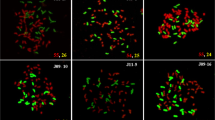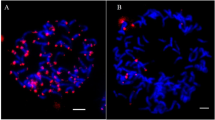Abstract
Erianthus arundinaceus, a wild relative of sugarcane, has great potential as a germplasm source to contribute valuable traits to sugarcane including better ratoonability, vigour and adaptation to biotic and abiotic stresses. Many unsuccessful attempts have been made to introduce the desirable characters from this wild species to modern sugarcane cultivars. In most of these cases, it was constrained by lack of fertility. A rare hybrid between E. arundinaceus (IK 76–78, 2n = 60) × Saccharum spontaneum (Iritty-2, 2n = 64) has been developed as an intermediate hybrid to transfer the characters from E. arundinaceus to sugarcane cultivars. This hybrid, CYM 04-420, with somatic chromosome number 2n = 62 was subjected to in vitro colchicine treatment, and amphiploids were developed with 2n = 124. We report here for the first time the chromosome composition and chromosome pairing behaviour of S. spontaneum × E. arundinaceus intergeneric amphiploid via genomic in situ hybridization. The implications of the results from this study for introgression of genes from E. arundinaceus in sugarcane breeding programmes are discussed in the paper.



Similar content being viewed by others
References
Alix, K., F.C. Baurens, F. Paulet, J.C. Glaszmann, and A. D’Hont. 1998. Isolation and characterization of a satellite DNA family in the Saccharum complex. Genome 41: 854–864.
Allum, J.F., D.H. Bringloe, and A.V. Roberts. 2007. Chromosome doubling in a Rosa rugosa Thunb. hybrid by exposure of in vitro nodes to oryzalin: The effects of node length, oryzalin concentration and exposure time. Plant Cell Reports 26: 1977–1984.
Chen, Y.H., C.C. Lo, and C. Chen. 1992. Colchicine-induced amphidiploids from cell cultures of Saccharum × Miscanthus hybrids. Reports of Taiwan Sugar Research Institute 136: 1–9.
Cohen, D., and J.L. Yao. 1996. In vitro chromosome doubling of nine Zantedeschia cultivars. Plant Cell, Tissue and Organ Culture 47: 43–49.
D’Hont, A., P.S. Rao, P. Feldmann, N. Berding, and J.C. Glaszmann. 1995. Identification and characterization of sugarcane intergeneric hybrids, Saccharum officinarum and Erianthus arundinaceus, with molecular markers and DNA in situ hybridization. Theoretical and Applied Genetics 91: 320–326.
Daniels, J., and B.T. Roach. 1987. Taxonomy and evolution. In Sugarcane improvement through breeding, ed. D.J. Heinz, 7–84. Amsterdam: Elsevier Press.
Daniels, J., P. Smith, N. Paton, and C.A. Williams. 1975. The origin of the genus Saccharum. Sugarcane Breeder’s Newsletter 36: 24–39.
Dhooghe, E., K. Van, T. Laere, L.Leus Eeckhaut, and J. Van Huylenbroeck. 2011. Mitotic chromosome doubling of plant tissues in vitro. Plant Cell, Tissue and Organ Culture 104: 359–373.
Doyle, J.J., and Doyle. J.L. 1990. Isolation of plant DNA from fresh tissue. Focus 12: 13–15.
Gill, B.S. 1991. Nucleocytoplasmic interaction (NCI) hypothesis of genome evolution and speciation in polyploid plants. In Proceedings of the Kihara memorial international symposium on cytoplasmic engineering in wheat, ed. T. Sasakurma, 48–53. Yokohama.
Heinz, D.J., and G.W.P. Mee. 1970. Colchicine induced polyploids from suspension cultures of sugarcane. Crop Science 10: 696–699.
Huang, Y., J. Wu, P. Wang, Y. Lin, C. Fu, Z. Deng, Q. Wang, Q. Li, R. Chen, and M. Zhang. 2015. Characterization of chromosome inheritance of the intergeneric BC2 and BC3 progeny between Saccharum spp. and E. arundinaceus. PLoS One 10: e0133722.
Janaki Ammal, E.K. 1941. Intergeneric hybrids of Saccharum. Journal of Genetics 41: 217–253.
Janaki Ammal, E.K., and T.S.N. Singh. 1936. A preliminary note on a new Saccharum–Sorghum hybrid. Indian Journal of Agricultural Science 6: 1105–1106.
Janaki Ammal, E.K. 1938. Chromosome behaviour in S. spontaneum × Sorghum durra hybrids. In Indian science congress association proceedings Part 3, Abstract 143.
Li, H.W., C.S. Loh, and C.L. Lee. 1948. Hybrids between Saccharum officinarum, Miscanthus japonicus and S. spontaneum. Botanical Bulletin of Academy of Since (Taipei) 2: 147–160.
Liu, B., and J.F. Wendel. 2002. Non-Mendelian phenomena in allopolyploid genome evolution. Current Genomics 3: 1–17.
Mandal, A., and A.K. Datta. 2011. Secondary chromosome associations and cytomixis in Corchorus spp. Cytologia 76(3): 337–343.
Mukherjee, S.K. 1957. Origin and distribution of Saccharum. Botany Gazette 119: 55–61.
Murashige, T., and R. Nakano. 1966. Tissue culture as a potential tool in obtaining polyploid plants. Journal of Heredity 57: 114–118.
Murashige, T., and F. Skoog. 1962. Revised medium for growth and bioassay with tobacco tissue cultures. Phisiology of Plants 15: 473–497.
Nagai, C., B.S. Ahloowalia, D.J. Heinz, and T.L. Tew. 1986. Colchicine induced aneuploids from cell cultures of sugarcane. Euphytica 35: 1029–1038.
Nair, N.V. 1999. Production and cytomorphological analysis of intergeneric hybrids of Sorghum × Saccharum. Euphytica 108: 187–191.
Nair, N.V., S. Nair, T.V. Sreenivasan, and M. Mohan. 1999. Analysis of genetic diversity and phylogeny in Saccharum and related genera using RAPD markers. Genetic Resources and Crop Evolution 46: 76–79.
Ostergren, G., and K.W. Haneen. 1962. A squash technique for chromosome morphological studies. Heredity 48: 332–341.
Piperidis, G., M.J. Christopher, B.J. Carroll, N. Berding, and A. D’Hont. 2000. Molecular contribution to selection of intergeneric hybrids between sugarcane and the wild species Erianthus arundinaceus. Genome 43: 1033–1037.
Piperidis, N., J. Chen, H. Deng, L. Wang, P. Jackson, and G. Piperidis. 2010. GISH characterization of Erianthus arundinaceus chromosomes in three generations of sugarcane intergeneric hybrids. Genome 53: 331–336.
Premachandran, M.N., S. Arvinth, and R. Lalitha. 2006. Chloroplast DNA polymorphism in psbC-trnS and trnL intron segments differentiate Saccharum and Erianthus. Indian Journal of Genetics and Plant Breeding 66(4): 283–286.
Premachandran, M.N., P.T. Prathima, and Maya Lekshmi. 2011a. Polyploidy in sugarcane—A review. Journal of Sugarcane Research 1(2): 1–15.
Premachandran, M.N., V. Raffee Viola, R. Lalitha, M. Lekshmi, and A.K. Remadevi. 2011b. Saccharum spontaneum as a bridge species for introgression of Erianthus arundinaceus and E. bengalense traits to sugarcane. In Balancing sugar and energy production in developing countries: Sustainable technologies and marketing technologies. Proceedings of international sugar conference IS 2011. New Delhi, 521–526.
Roach, B.T. 1989. A programme for sugarcane improvement from genetic diversity: Background and preliminary results. Proceedings of International Society of Sugarcane Technology 20: 900–909.
Tal, M. 1980. Physiology of polyploids. In Polyploidy: Biological relevance, vol. 13, ed. W.H. Lewis, 61–76. New York: Plenum Press.
Thomas, R., and T.S. Venkataraman. 1930. Sugarcane—Sorghum hybrids. Agricultural Journal of India 25: 164.
Wu, J., Y. Huang, Y. Lin, C. Fu, S. Liu, Z. Deng, Q. Li, Z. Huang, R. Chen, and R. Zhang. 2014. Unexpected inheritance pattern of Erianthus arundinaceus chromosomes in the intergeneric progeny between Saccharum spp. and Erianthus arundinaceus. PLoS One 9: e110390.
Xiong, Y.C., F.M. Li, and T. Zhang. 2006. Performance of wheat crops with different chromosome ploidy: Root-sourced signals, drought tolerance, and yield performance. Planta 224: 710–718.
Funding
This study was funded by ICAR.
Author information
Authors and Affiliations
Corresponding author
Ethics declarations
Conflict of interest
We, the authors, declare that we have no conflict of interest.
Rights and permissions
About this article
Cite this article
Premachandran, M.N., Sobhakumari, V.P., Lekshmi, M. et al. Genome Characterization of In Vitro Induced Amphiploids of an Intergeneric Hybrid Erianthus arundinaceus × Saccharum spontaneum . Sugar Tech 19, 386–393 (2017). https://doi.org/10.1007/s12355-016-0482-6
Received:
Accepted:
Published:
Issue Date:
DOI: https://doi.org/10.1007/s12355-016-0482-6




